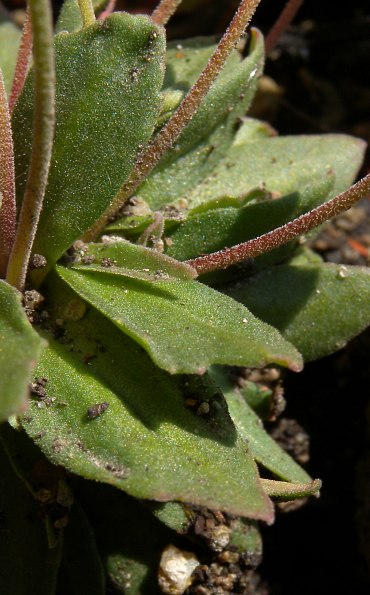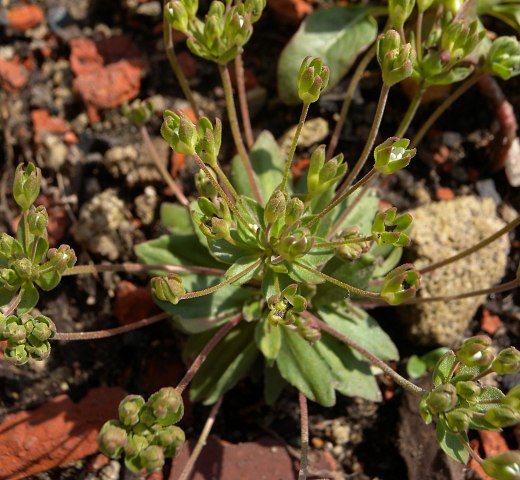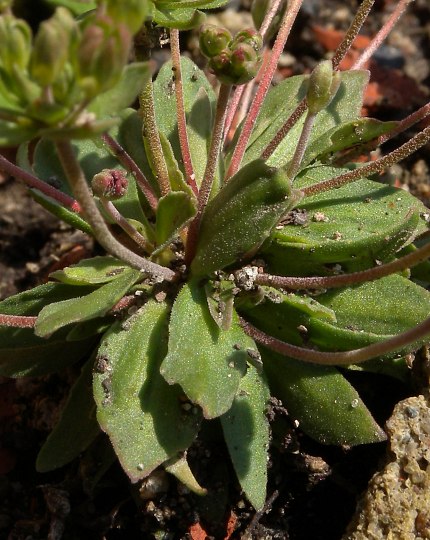
The secondary flowering stalks are similar to the primary flowering stalks, except they are usually shorter. The secondary umbels of flowers are similar to the primary umbels of flowers, except they tend to have fewer flowers. The pedicels of the flowers (or seed capsules) are 3–25 mm. (1/8–1") in length and erect to upwardly arching. Compared to the flowering stalks (peduncles), the pedicels are shorter and more slender, although they become longer as the seed capsules develop. Individual flowers are about 2 mm. across and 4 mm. long; each flower has a green calyx with 5 erect teeth, a white tubular corolla with 5 ascending lobes, 5 inserted stamens with short filaments, and a light green ovary with a single short style. The calyx is 5-angular from 5 ridges and it has sparse minute pubescence. The teeth of the calyx extend above the lobes of the corolla. Individual lobes of the corolla are lanceolate in shape. The teeth of the calyx are narrowly deltate to deltate in shape and a little shorter than the angular calyx-tube.

At the base of each umbel (or secondary umbel) of flowers, there are 2 or more leafy bracts that resemble the basal leaves, except they are smaller in size (less than 0.5 cm. or ¼" in length) and they lack teeth; sometimes they form a small rosette. The blooming period occurs from from early to late spring, lasting about 1 month. The flowers are inconspicuous. Afterwards, they are replaced by small seed capsules. These capsules are about 3 mm. long and ovoid in shape; each capsule eventually divides into 5 sections to release several seeds. These seeds are small enough to be blown about by the wind. Mature seeds are about 1 mm. long, 0.75 mm. across, 3-angled, and dark brown to black; the seed surface has a network of minute ridges and pits. The root system consists of a slender taproot. This plant reproduces by reseeding itself. It dies down no later than mid-summer.
Cultivation: The preference is full to partial sun, mesic to dry conditions, and a barren soil containing sand, gravel, clay, or rocky debris. Most growth and development occurs during the spring, which happens very quickly.

Range & Habitat: Western Rock Jasmine (Androsace occidentalis) is a native plant in Illinois, where it occurs occasionally in western and northern Illinois, while in the rest of the state it is uncommon or absent (see Distribution Map). This plant is more common in drier areas to the west of Illinois. In Indiana, Ohio, and Michigan, this plant is rare and state-listed as 'threatened' or 'endangered.' Habitats include gravel hill prairies, upland sand prairies, upland dolomite prairies, gravelly or sandy areas along railroads, roadsides, pastures, fallow fields, and waste ground. In Illinois, Western Rock Jasmine occurs in both higher quality natural areas and disturbed areas on exposed ground soil where it is dry and sunny.
Faunal Associations: This plant becomes more common in pastures that are moderately to heavily grazed by cattle as this reduces competition from taller and more aggressive plants (Patton & Nyren, 2015).

Photographic Location: Found on waste ground along an alley way in Urbana, Illinois. This dumped waste ground contained broken bricks and pieces of concrete.
Comments: This tiny plant has inconspicuous flowers and it is easily overlooked. When the stalks with umbels of flowers are produced, it fairly easy to identify, however. Western Rock Jasmine (Androsace occidentalis) is the only species of its genus that has been found in Illinois. Further to the west, however, there are several Rock Jasmine species (Androsace spp.). These more western species tend to be less weedy in appearance and they have showier flowers. Other common names for Androsace occidentalis are Western Rock Primrose and Western Fairy Candelabra. Sometimes this plant is simply referred to as Rock Jasmine, Rock Primrose, or Fairy Candelabra.